Serbian vs Bangladeshi Community Comparison
COMPARE
Serbian
Bangladeshi
Social Comparison
Social Comparison
Serbians
Bangladeshis
8,746
SOCIAL INDEX
84.9/ 100
SOCIAL RATING
53rd/ 347
SOCIAL RANK
2,611
SOCIAL INDEX
23.6/ 100
SOCIAL RATING
249th/ 347
SOCIAL RANK
Bangladeshi Integration in Serbian Communities
The statistical analysis conducted on geographies consisting of 106,399,188 people shows a moderate positive correlation between the proportion of Bangladeshis within Serbian communities in the United States with a correlation coefficient (R) of 0.469. On average, for every 1% (one percent) increase in Serbians within a typical geography, there is an increase of 0.172% in Bangladeshis. To illustrate, in a geography comprising of 100,000 individuals, a rise of 1,000 Serbians corresponds to an increase of 171.6 Bangladeshis.
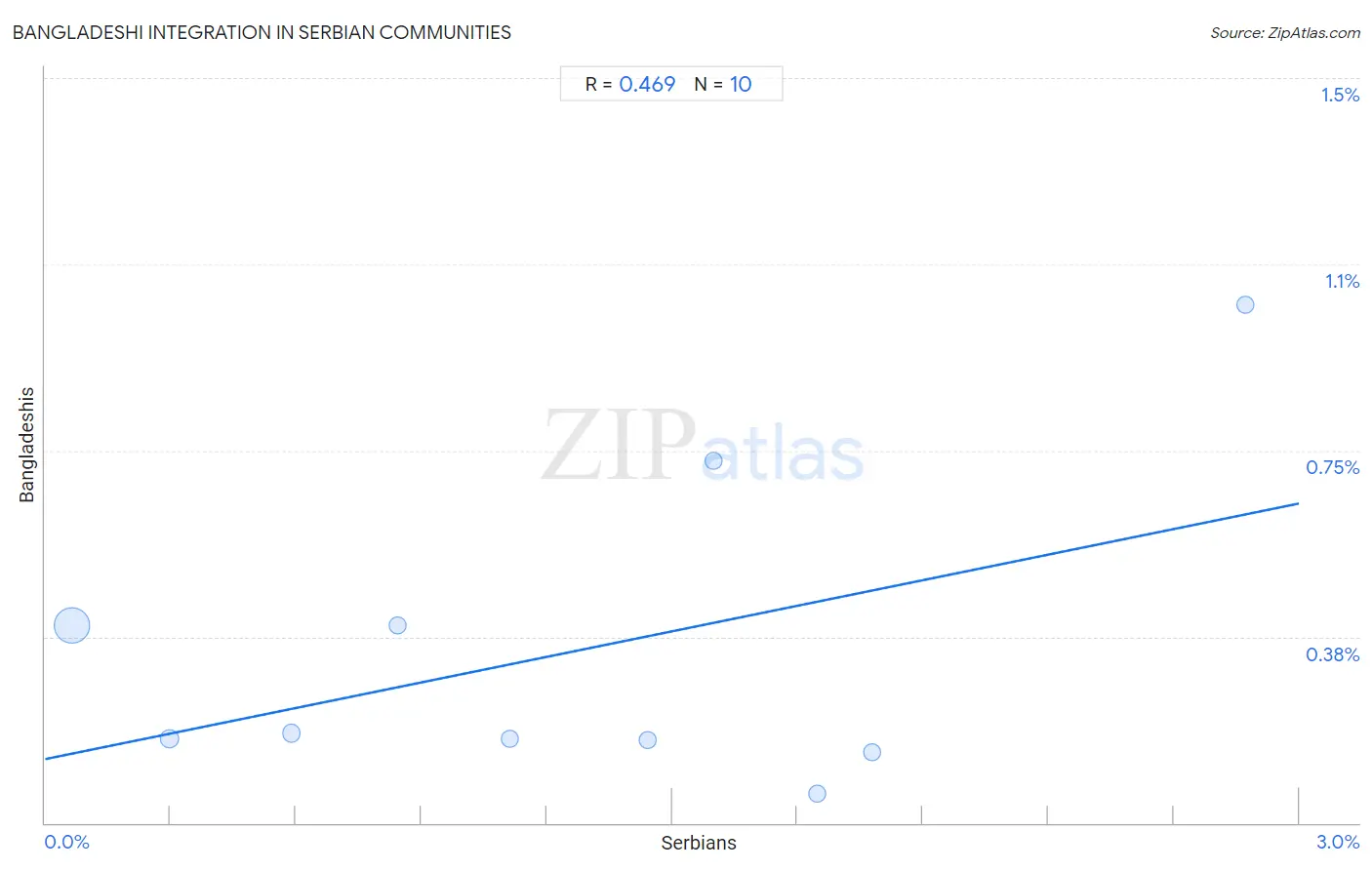
Serbian vs Bangladeshi Income
When considering income, the most significant differences between Serbian and Bangladeshi communities in the United States are seen in per capita income ($46,551 compared to $35,897, a difference of 29.7%), wage/income gap (27.7% compared to 22.2%, a difference of 24.9%), and median male earnings ($57,975 compared to $46,744, a difference of 24.0%). Conversely, both communities are more comparable in terms of householder income under 25 years ($51,106 compared to $47,589, a difference of 7.4%), householder income over 65 years ($61,087 compared to $54,719, a difference of 11.6%), and median female earnings ($40,539 compared to $35,960, a difference of 12.7%).

| Income Metric | Serbian | Bangladeshi |
| Per Capita Income | Exceptional $46,551 | Tragic $35,897 |
| Median Family Income | Exceptional $107,157 | Tragic $88,358 |
| Median Household Income | Excellent $87,572 | Tragic $74,112 |
| Median Earnings | Exceptional $48,677 | Tragic $41,263 |
| Median Male Earnings | Exceptional $57,975 | Tragic $46,744 |
| Median Female Earnings | Excellent $40,539 | Tragic $35,960 |
| Householder Age | Under 25 years | Tragic $51,106 | Tragic $47,589 |
| Householder Age | 25 - 44 years | Excellent $98,320 | Tragic $81,363 |
| Householder Age | 45 - 64 years | Excellent $103,522 | Tragic $86,402 |
| Householder Age | Over 65 years | Average $61,087 | Tragic $54,719 |
| Wage/Income Gap | Tragic 27.7% | Exceptional 22.2% |
Serbian vs Bangladeshi Poverty
When considering poverty, the most significant differences between Serbian and Bangladeshi communities in the United States are seen in receiving food stamps (10.3% compared to 15.0%, a difference of 45.9%), married-couple family poverty (4.3% compared to 6.0%, a difference of 39.7%), and family poverty (8.0% compared to 10.9%, a difference of 36.9%). Conversely, both communities are more comparable in terms of single male poverty (12.5% compared to 13.3%, a difference of 7.1%), seniors poverty over the age of 75 (11.1% compared to 12.0%, a difference of 7.5%), and single father poverty (16.4% compared to 15.2%, a difference of 7.7%).
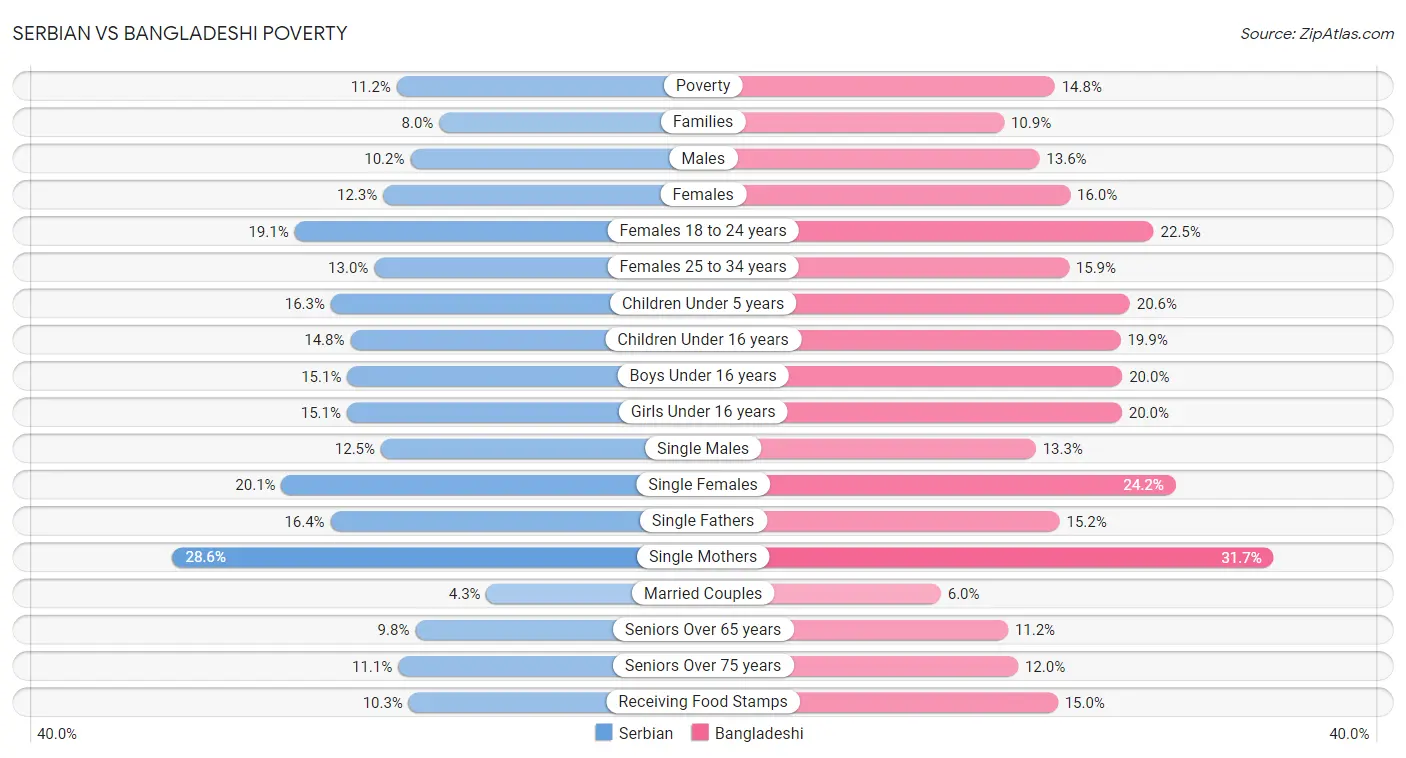
| Poverty Metric | Serbian | Bangladeshi |
| Poverty | Exceptional 11.2% | Tragic 14.8% |
| Families | Exceptional 8.0% | Tragic 10.9% |
| Males | Exceptional 10.2% | Tragic 13.6% |
| Females | Exceptional 12.3% | Tragic 16.0% |
| Females 18 to 24 years | Exceptional 19.1% | Tragic 22.5% |
| Females 25 to 34 years | Excellent 13.0% | Tragic 15.9% |
| Children Under 5 years | Excellent 16.3% | Tragic 20.6% |
| Children Under 16 years | Exceptional 14.8% | Tragic 19.9% |
| Boys Under 16 years | Exceptional 15.1% | Tragic 20.0% |
| Girls Under 16 years | Exceptional 15.1% | Tragic 20.0% |
| Single Males | Excellent 12.5% | Tragic 13.3% |
| Single Females | Exceptional 20.1% | Tragic 24.2% |
| Single Fathers | Average 16.4% | Exceptional 15.2% |
| Single Mothers | Excellent 28.6% | Tragic 31.7% |
| Married Couples | Exceptional 4.3% | Tragic 6.0% |
| Seniors Over 65 years | Exceptional 9.8% | Fair 11.2% |
| Seniors Over 75 years | Exceptional 11.1% | Good 12.0% |
| Receiving Food Stamps | Exceptional 10.3% | Tragic 15.0% |
Serbian vs Bangladeshi Unemployment
When considering unemployment, the most significant differences between Serbian and Bangladeshi communities in the United States are seen in unemployment among women with children ages 6 to 17 years (8.8% compared to 7.4%, a difference of 19.3%), unemployment among seniors over 75 years (8.4% compared to 9.6%, a difference of 14.0%), and male unemployment (5.1% compared to 5.7%, a difference of 12.2%). Conversely, both communities are more comparable in terms of unemployment among ages 30 to 34 years (5.4% compared to 5.3%, a difference of 0.34%), unemployment among ages 55 to 59 years (4.7% compared to 4.7%, a difference of 0.49%), and unemployment among ages 16 to 19 years (16.7% compared to 16.9%, a difference of 1.5%).
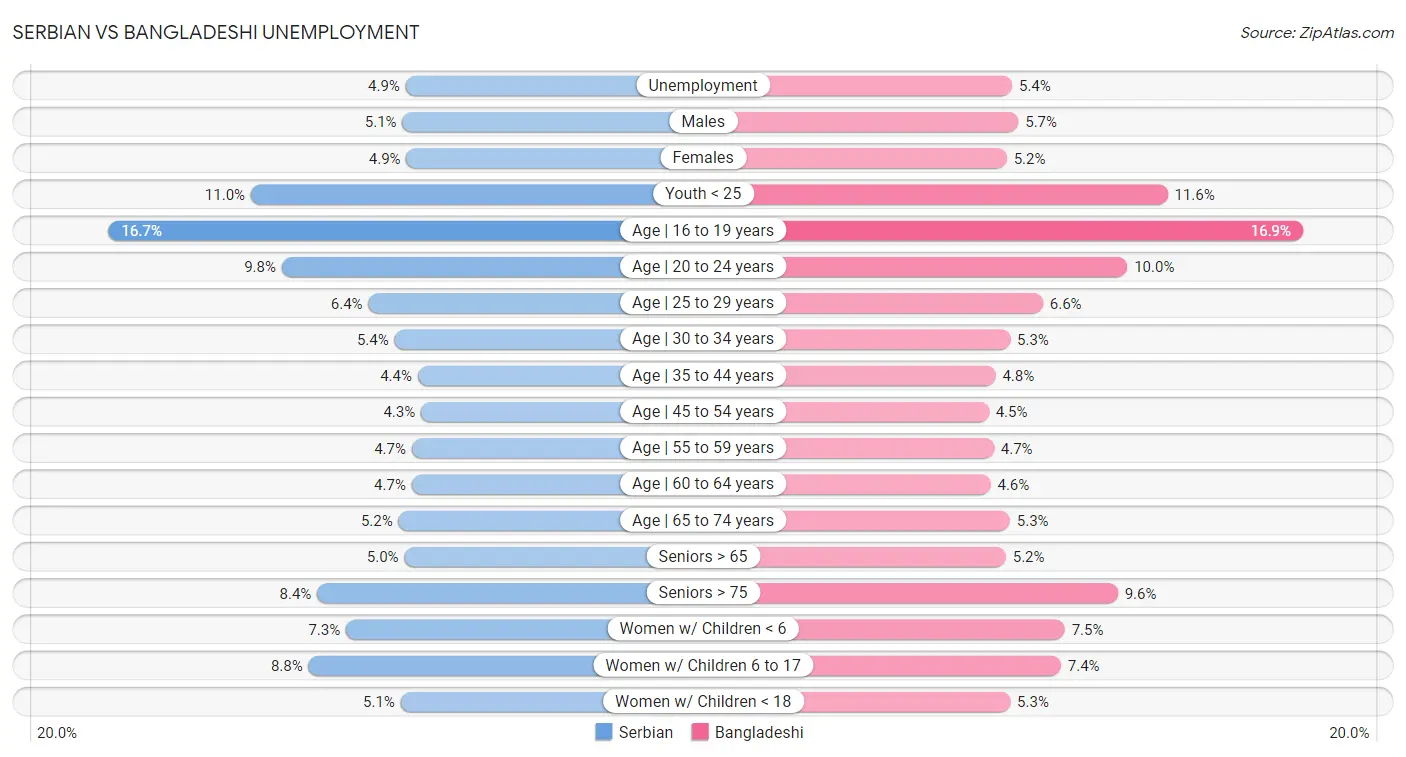
| Unemployment Metric | Serbian | Bangladeshi |
| Unemployment | Exceptional 4.9% | Poor 5.4% |
| Males | Exceptional 5.1% | Tragic 5.7% |
| Females | Exceptional 4.9% | Good 5.2% |
| Youth < 25 | Exceptional 11.0% | Average 11.6% |
| Age | 16 to 19 years | Exceptional 16.7% | Exceptional 16.9% |
| Age | 20 to 24 years | Exceptional 9.8% | Exceptional 10.0% |
| Age | 25 to 29 years | Exceptional 6.4% | Average 6.6% |
| Age | 30 to 34 years | Good 5.4% | Good 5.3% |
| Age | 35 to 44 years | Exceptional 4.4% | Fair 4.8% |
| Age | 45 to 54 years | Exceptional 4.3% | Average 4.5% |
| Age | 55 to 59 years | Exceptional 4.7% | Exceptional 4.7% |
| Age | 60 to 64 years | Exceptional 4.7% | Exceptional 4.6% |
| Age | 65 to 74 years | Exceptional 5.2% | Good 5.3% |
| Seniors > 65 | Exceptional 5.0% | Fair 5.2% |
| Seniors > 75 | Exceptional 8.4% | Tragic 9.6% |
| Women w/ Children < 6 | Exceptional 7.3% | Good 7.5% |
| Women w/ Children 6 to 17 | Excellent 8.8% | Exceptional 7.4% |
| Women w/ Children < 18 | Exceptional 5.1% | Good 5.3% |
Serbian vs Bangladeshi Labor Participation
When considering labor participation, the most significant differences between Serbian and Bangladeshi communities in the United States are seen in in labor force | age 16-19 (39.9% compared to 42.5%, a difference of 6.3%), in labor force | age 45-54 (83.4% compared to 81.3%, a difference of 2.6%), and in labor force | age 30-34 (85.8% compared to 84.3%, a difference of 1.7%). Conversely, both communities are more comparable in terms of in labor force | age 25-29 (85.5% compared to 85.1%, a difference of 0.45%), in labor force | age > 16 (65.2% compared to 65.9%, a difference of 1.1%), and in labor force | age 20-24 (77.3% compared to 78.1%, a difference of 1.1%).

| Labor Participation Metric | Serbian | Bangladeshi |
| In Labor Force | Age > 16 | Good 65.2% | Exceptional 65.9% |
| In Labor Force | Age 20-64 | Exceptional 80.3% | Poor 79.3% |
| In Labor Force | Age 16-19 | Exceptional 39.9% | Exceptional 42.5% |
| In Labor Force | Age 20-24 | Exceptional 77.3% | Exceptional 78.1% |
| In Labor Force | Age 25-29 | Exceptional 85.5% | Exceptional 85.1% |
| In Labor Force | Age 30-34 | Exceptional 85.8% | Tragic 84.3% |
| In Labor Force | Age 35-44 | Exceptional 85.1% | Poor 84.1% |
| In Labor Force | Age 45-54 | Exceptional 83.4% | Tragic 81.3% |
Serbian vs Bangladeshi Family Structure
When considering family structure, the most significant differences between Serbian and Bangladeshi communities in the United States are seen in single mother households (5.7% compared to 8.1%, a difference of 42.1%), single father households (2.2% compared to 3.1%, a difference of 40.2%), and family households with children (26.4% compared to 30.1%, a difference of 14.2%). Conversely, both communities are more comparable in terms of family households (63.0% compared to 64.3%, a difference of 1.9%), divorced or separated (12.0% compared to 12.3%, a difference of 2.1%), and married-couple households (47.0% compared to 43.5%, a difference of 7.9%).

| Family Structure Metric | Serbian | Bangladeshi |
| Family Households | Tragic 63.0% | Average 64.3% |
| Family Households with Children | Tragic 26.4% | Exceptional 30.1% |
| Married-couple Households | Good 47.0% | Tragic 43.5% |
| Average Family Size | Tragic 3.12 | Exceptional 3.37 |
| Single Father Households | Exceptional 2.2% | Tragic 3.1% |
| Single Mother Households | Exceptional 5.7% | Tragic 8.1% |
| Currently Married | Exceptional 47.8% | Tragic 43.7% |
| Divorced or Separated | Average 12.0% | Poor 12.3% |
| Births to Unmarried Women | Good 30.7% | Tragic 34.4% |
Serbian vs Bangladeshi Vehicle Availability
When considering vehicle availability, the most significant differences between Serbian and Bangladeshi communities in the United States are seen in 4 or more vehicles in household (6.0% compared to 7.6%, a difference of 26.1%), 3 or more vehicles in household (19.1% compared to 21.9%, a difference of 14.6%), and no vehicles in household (9.4% compared to 8.7%, a difference of 8.7%). Conversely, both communities are more comparable in terms of 1 or more vehicles in household (90.7% compared to 91.4%, a difference of 0.79%), 2 or more vehicles in household (56.1% compared to 58.4%, a difference of 4.1%), and no vehicles in household (9.4% compared to 8.7%, a difference of 8.7%).

| Vehicle Availability Metric | Serbian | Bangladeshi |
| No Vehicles Available | Exceptional 9.4% | Exceptional 8.7% |
| 1+ Vehicles Available | Exceptional 90.7% | Exceptional 91.4% |
| 2+ Vehicles Available | Excellent 56.1% | Exceptional 58.4% |
| 3+ Vehicles Available | Fair 19.1% | Exceptional 21.9% |
| 4+ Vehicles Available | Poor 6.0% | Exceptional 7.6% |
Serbian vs Bangladeshi Education Level
When considering education level, the most significant differences between Serbian and Bangladeshi communities in the United States are seen in no schooling completed (1.7% compared to 3.5%, a difference of 111.9%), doctorate degree (2.0% compared to 1.2%, a difference of 63.3%), and professional degree (4.8% compared to 3.1%, a difference of 55.7%). Conversely, both communities are more comparable in terms of nursery school (98.4% compared to 96.6%, a difference of 1.9%), kindergarten (98.4% compared to 96.6%, a difference of 1.9%), and 1st grade (98.3% compared to 96.5%, a difference of 1.9%).
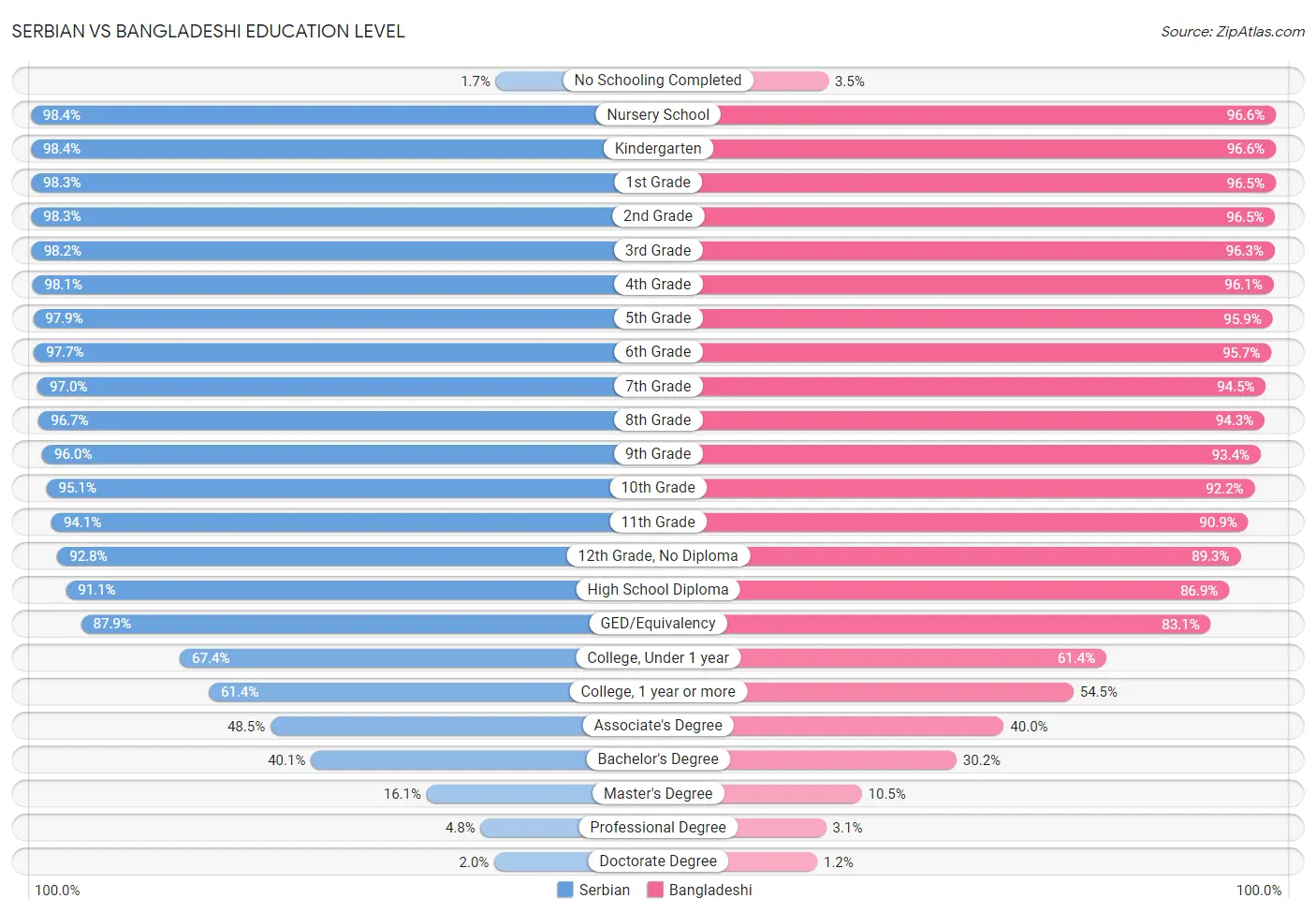
| Education Level Metric | Serbian | Bangladeshi |
| No Schooling Completed | Exceptional 1.7% | Tragic 3.5% |
| Nursery School | Exceptional 98.4% | Tragic 96.6% |
| Kindergarten | Exceptional 98.4% | Tragic 96.6% |
| 1st Grade | Exceptional 98.3% | Tragic 96.5% |
| 2nd Grade | Exceptional 98.3% | Tragic 96.5% |
| 3rd Grade | Exceptional 98.2% | Tragic 96.3% |
| 4th Grade | Exceptional 98.1% | Tragic 96.1% |
| 5th Grade | Exceptional 97.9% | Tragic 95.9% |
| 6th Grade | Exceptional 97.7% | Tragic 95.7% |
| 7th Grade | Exceptional 97.0% | Tragic 94.5% |
| 8th Grade | Exceptional 96.7% | Tragic 94.3% |
| 9th Grade | Exceptional 96.0% | Tragic 93.4% |
| 10th Grade | Exceptional 95.1% | Tragic 92.2% |
| 11th Grade | Exceptional 94.1% | Tragic 90.9% |
| 12th Grade, No Diploma | Exceptional 92.8% | Tragic 89.3% |
| High School Diploma | Exceptional 91.1% | Tragic 86.9% |
| GED/Equivalency | Exceptional 87.9% | Tragic 83.1% |
| College, Under 1 year | Exceptional 67.4% | Tragic 61.4% |
| College, 1 year or more | Exceptional 61.4% | Tragic 54.5% |
| Associate's Degree | Exceptional 48.5% | Tragic 40.0% |
| Bachelor's Degree | Exceptional 40.1% | Tragic 30.2% |
| Master's Degree | Exceptional 16.1% | Tragic 10.5% |
| Professional Degree | Exceptional 4.8% | Tragic 3.1% |
| Doctorate Degree | Excellent 2.0% | Tragic 1.2% |
Serbian vs Bangladeshi Disability
When considering disability, the most significant differences between Serbian and Bangladeshi communities in the United States are seen in disability age 35 to 64 (11.0% compared to 13.6%, a difference of 23.4%), disability age 65 to 74 (22.3% compared to 26.8%, a difference of 20.4%), and self-care disability (2.4% compared to 2.8%, a difference of 18.0%). Conversely, both communities are more comparable in terms of disability age under 5 (1.3% compared to 1.3%, a difference of 1.2%), ambulatory disability (6.1% compared to 6.3%, a difference of 2.0%), and hearing disability (3.3% compared to 3.2%, a difference of 3.1%).
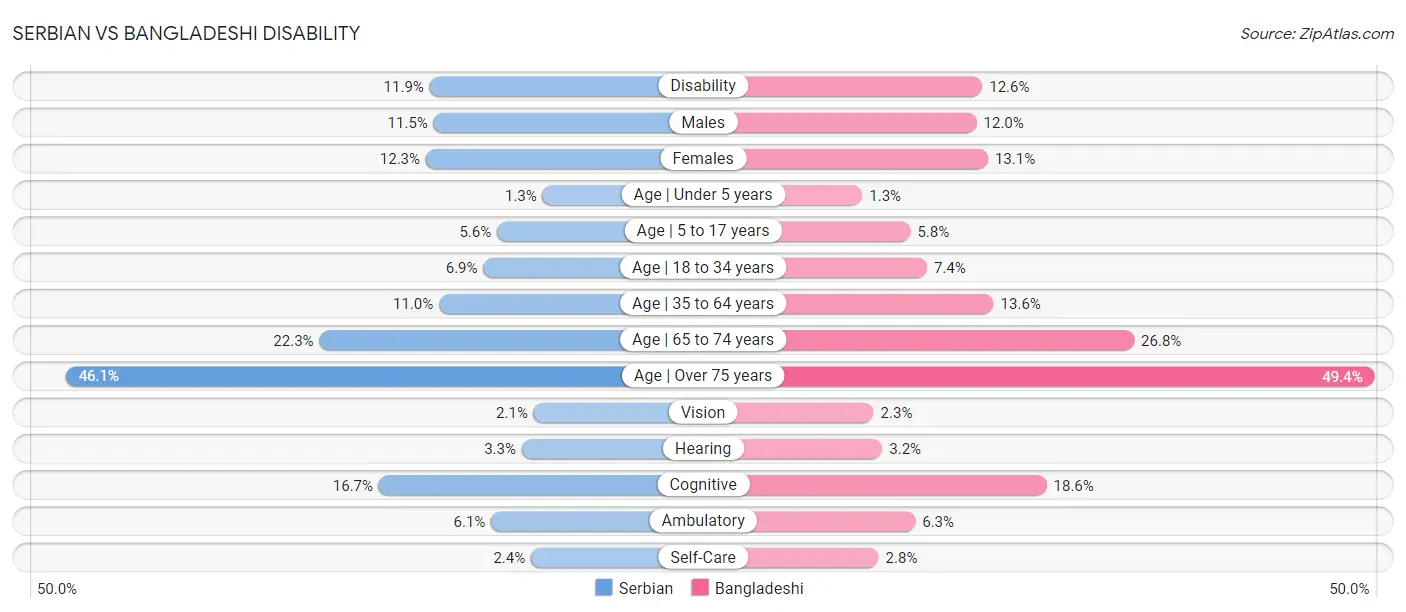
| Disability Metric | Serbian | Bangladeshi |
| Disability | Poor 11.9% | Tragic 12.6% |
| Males | Poor 11.5% | Tragic 12.0% |
| Females | Fair 12.3% | Tragic 13.1% |
| Age | Under 5 years | Tragic 1.3% | Poor 1.3% |
| Age | 5 to 17 years | Average 5.6% | Tragic 5.8% |
| Age | 18 to 34 years | Tragic 6.9% | Tragic 7.4% |
| Age | 35 to 64 years | Good 11.0% | Tragic 13.6% |
| Age | 65 to 74 years | Exceptional 22.3% | Tragic 26.8% |
| Age | Over 75 years | Exceptional 46.1% | Tragic 49.4% |
| Vision | Good 2.1% | Tragic 2.3% |
| Hearing | Tragic 3.3% | Tragic 3.2% |
| Cognitive | Exceptional 16.7% | Tragic 18.6% |
| Ambulatory | Average 6.1% | Poor 6.3% |
| Self-Care | Exceptional 2.4% | Tragic 2.8% |